Breast Lift
Breast lift surgery, also known as “mastopexy,” corrects sagging, pendulous breasts by removing excess skin and tightening the breast tissue.
Model
If a smaller lifted breast is desired then breast tissue is removed as well to contour the breast. The breasts and areolas are raised to a higher position, made firmer, and shaped into more attractive and youthful contours. If you’re considering breast lift surgery, consult a board-certified plastic surgeon. It’s important to understand what breast lift surgery entails, including possible risks and complications as well as set realistic expectations.
Reasons to Undergo Breast Lift Surgery
Having youthful, lifted breasts with an attractive shape can improve a woman’s confidence and self-image. The following circumstances are often unavoidable and can result in a breast appearance that is less than desirable and detracts from a woman’s confidence. Improving how one sees themselves is a major component of our philosophy.
Aging
As we age, our skin loses collagen and elastin – structural proteins that keep the skin firm and tight. As these proteins deteriorate over time, the skin stretches more easily and loses its ability to return to its original form. This leads to thin, loose breast skin that cannot support the tissues and often results in sagging breasts.
Weight Loss
Weight gain causes the breast skin to stretch to accommodate for the increase in volume due to excess fat. After weight loss, the skin is often unable to shrink back completely because it has been stretched too much and/or for too long, resulting in breasts with loose, wrinkled skin and an unattractive shape. This is compounded by the aging process.
Pregnancy
Similar to weight gain, pregnancy causes the breasts to swell and the skin to stretch to accommodate for the increase in size. After pregnancy and breastfeeding, the breasts generally return to their normal size but are left with loose skin that allows them to droop down. This happens whether a woman breast feeds or not.
Model
Breast Lift Options
Crescent Lift
- Ideal For: Slight sagging of breast and areola
- Technique: A crescent of skin above the top of the areola is removed. Very little to no breast tissue removed.
- Benefit: Least invasive; produces inconspicuous scarring that blends with your areola. This technique is limited to a small number of patients.
Benelli Lift
- Ideal For: Minimal sagging and slight nipple asymmetry
- Technique: A doughnut-shaped area of skin around the areola is removed. Some areola can be removed to decrease the size and provide symmetry. Breast tissue is also able to be removed with this technique.
- Benefit: Produces inconspicuous scarring around the areola. Also limited to a small number of patients.
Lollipop Lift or Vertical Lift
- Ideal For: Moderate sagging and stretched nipples
- Technique: A lollipop-shaped incision around the nipple and down to the breast crease is used to remove excess skin and tissue.
- Benefit: Effectively lifts low-hanging breasts and allows tightening of the breast in a vertical and horizontal plane.
Anchor Lift or Inverted T Lift
- Ideal For: Severely sagging, pendulous breasts
- Technique: A lollipop-shaped incision that also extends along the breast crease is used to remove excess tissue. A variation of this technique allows the incision to be shaped in a J or L so the scar along the breast crease is directed only laterally and no scar medially.
- Benefit: Provides the most significant lift to the breasts and allows more tightening of the breast in a horizontal plane.
Breast Lift Before & After Photos
Details
2 month postop
- Procedure: Removal of 310cc saline implants, circumvertical mastopexy with fat grafting to breast and liposuction with abdominal etching
- Age: 35-45 yo female
- BMI: 20
- Weight: 118 lbs
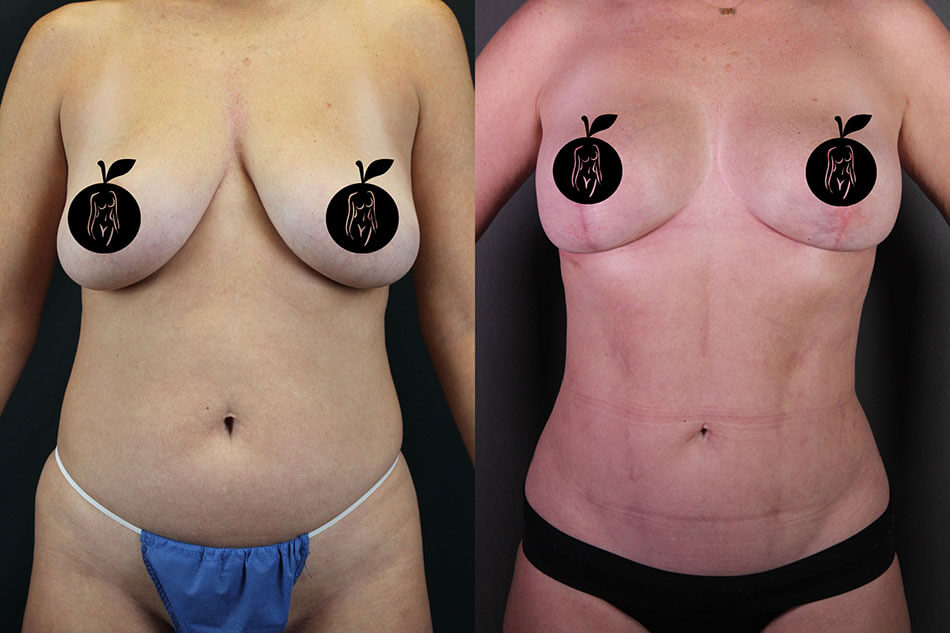
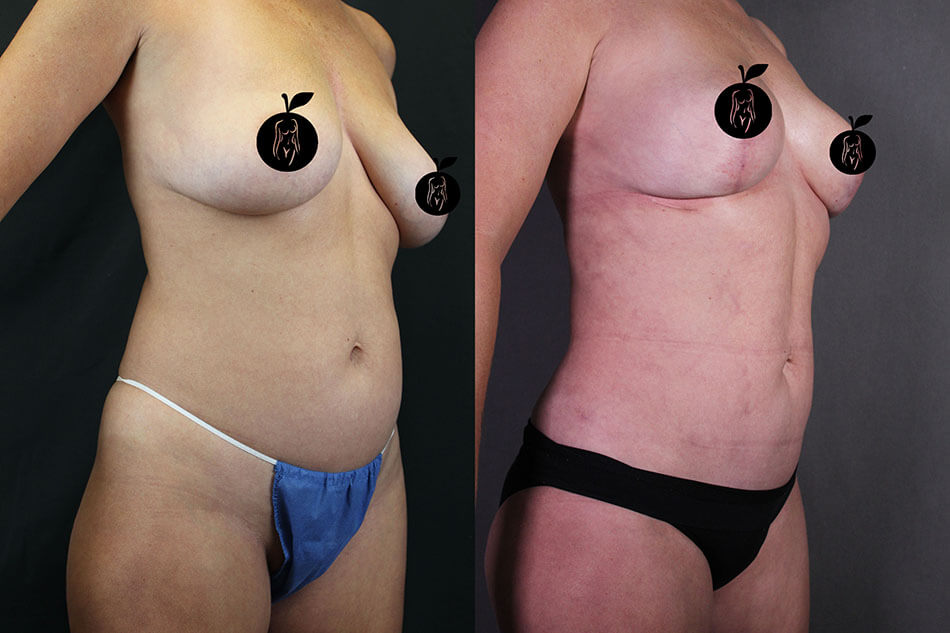

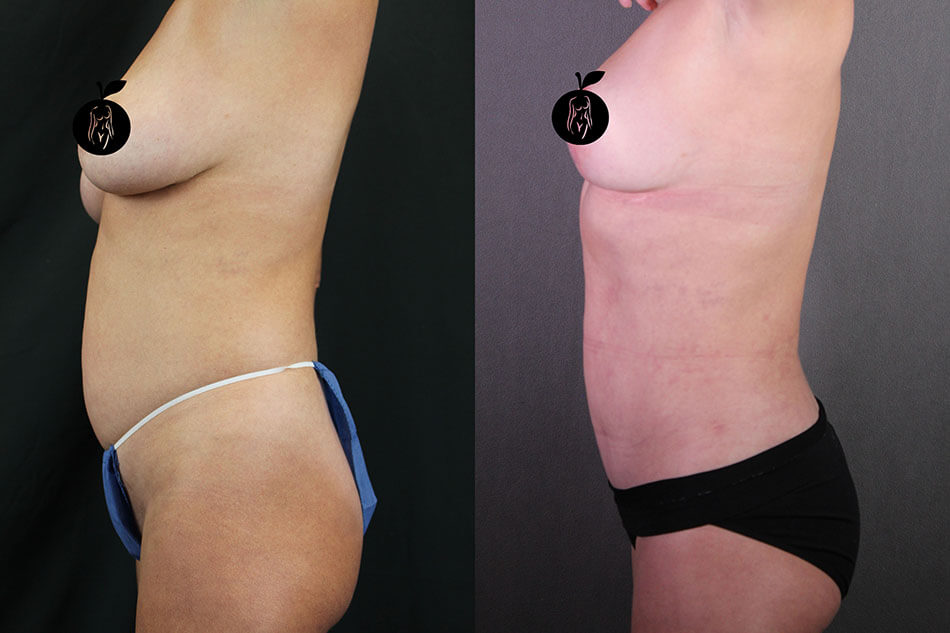
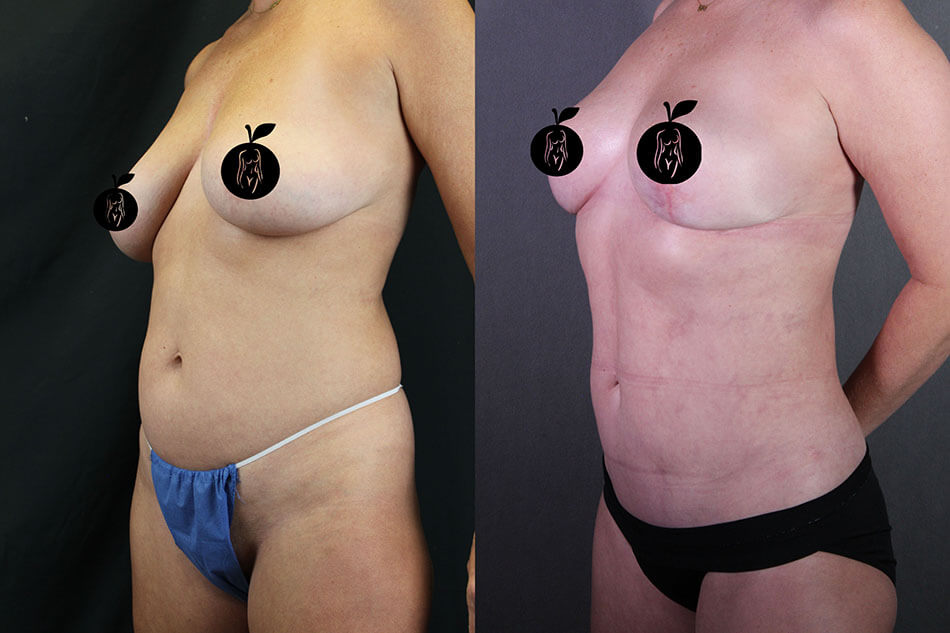
The Breast Lift Process
Consultation
Once you fill out the online questionnaire, you will be contacted to confirm an appointment for a one-on-one consultation with the surgeon. You may also provide photos through our HIPAA compliant system and during your visit your surgeon can provide a personal 3D simulation using your own photos. This tool is a powerful education tool that helps identify what can and cannot be performed.
This appointment also includes an analysis of your health history, any medications you are taking, and what you desire to achieve with the procedure. Please have all of this information with you when you come to your appointment. All of which can be submitted electronically through our HIPAA compliant patient portal.
You will have a breast exam and a mammogram before the procedure to be as sure
as possible that you do not have cancer.
The surgeon will discuss the techniques that will best provide you with the results you desire and answer any questions you may have. Discuss the size and shape of breasts you want to have with your healthcare provider. If you are planning to have children and want to breastfeed, talk with your provider about this.
Preoperative Instructions
Your surgeon will review in detail all of the information you need to know prior to surgery.
Generally, patients should avoid nicotine products six weeks before surgery and stop taking anti-inflammatory medication (e.g., aspirin and ibuprofen) for at least two weeks before surgery. Some vitamins and supplements may also cause problems during or after surgery, so it is best to avoid them or to talk to your surgeon about potential side effects.
You may be asked to bathe using an antibacterial soap before your procedure.
Eating and drinking restrictions include:
- 8 hours before the procedure – stop eating heavy meals or foods, such as meat, fried foods, or fatty foods.
- 6 hours before the procedure – stop eating light meals or foods, such as toast or cereal.
- 6 hours before the procedure – stop drinking milk or drinks that contain milk.
- 2 hours before the procedure – stop drinking clear liquids.
You may be asked to obtain blood tests and/or a mammogram.
Be sure to arrange for someone to drive you home and care for you for the first 48 hours after your procedure.
Model
During the Procedure
Breast lift is performed with general anesthesia, in a surgery center, and takes approximately three hours to complete. An IV will be inserted into one of your veins. Based on the techniques agreed upon during your consultation, the surgeon will place the incisions as described above. Incisions are closed with absorbable sutures and covered with surgical tape. In most cases drains are not used but not uncommon. Liposuction and fat grafting are tools that helps shape the breast and will be discussed during your consultation.
Recovery
After surgery, your blood pressure, heart rate, breathing rate, and blood oxygen level will be monitored until you leave the surgical center. You may continue to receive fluids and pain medicines through an IV.
You will have to wear compression stockings to help prevent blood clots and reduce swelling in your legs. You will be advised to wear a loose fitting bra with mild compression to aid with breast swelling and to keep you comfortable. Breast swelling will typically subside after about three weeks but may last as long as 6 months.
Expect pain, bruising, and tenderness for which you will be provided pain medications as needed.
For the first few days after surgery you will need to get plenty of rest. Most patients are able to return to work in one-two weeks and resume regular exercise after about six weeks.
Your surgeon will give you more detailed information about what you can expect during your recovery.
Common Breast Lift Concerns
Pain
During the procedure, medications will be administered for your comfort. Minimal pain and discomfort generally exist after the procedure and can be controlled with prescribed medication.
Recovery
Most patients are able to return to work within a week of their surgery, but they should avoid strenuous activities for several weeks. Your doctor will give you specific instructions to follow to ensure you have the safest and most effective recovery.
Scars
The location of the incisions and resulting scars will depend on the degree of correction needed. With all incision techniques, the scars will be as inconspicuous as possible and continue to improve over time. You will be provided with scar massage techniques and asked to obtain scar silicone tapes and or gels to decrease the scar burden.
Duration of Results
The resulting lifted breast and areola position and improved breast shape will be long lasting. However, the breasts will continue to age naturally and may be affected by weight fluctuations.
Breast Lift Before & After Photos
Details
2 month postop
- Procedure: Removal of 310cc saline implant removal and circumvertical mastopexy with fat transfer to breast
- Age: 35-45 yo female
- BMI: 20
- Weight: 118 lbs
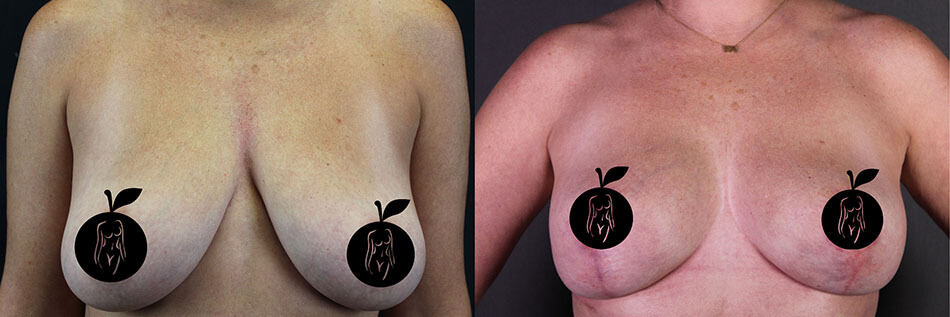
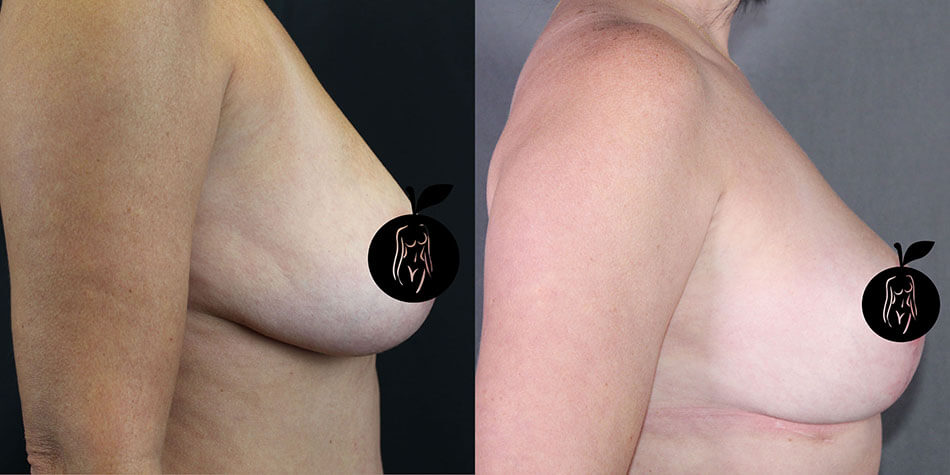
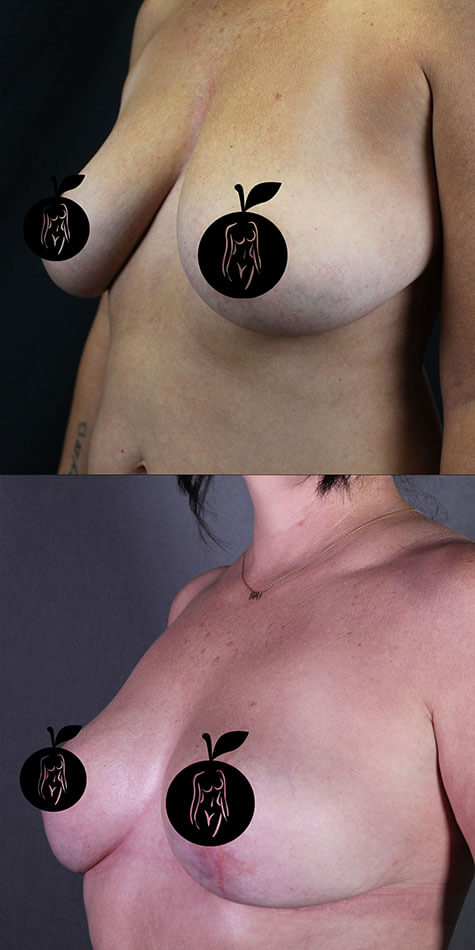
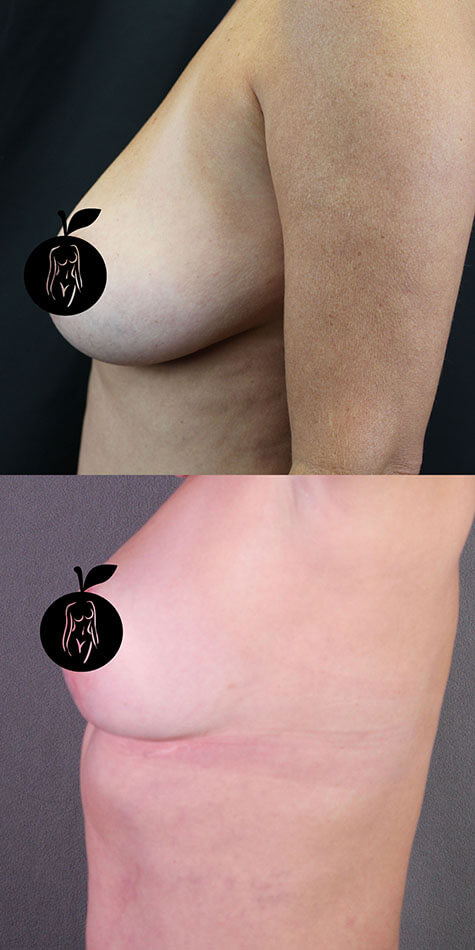
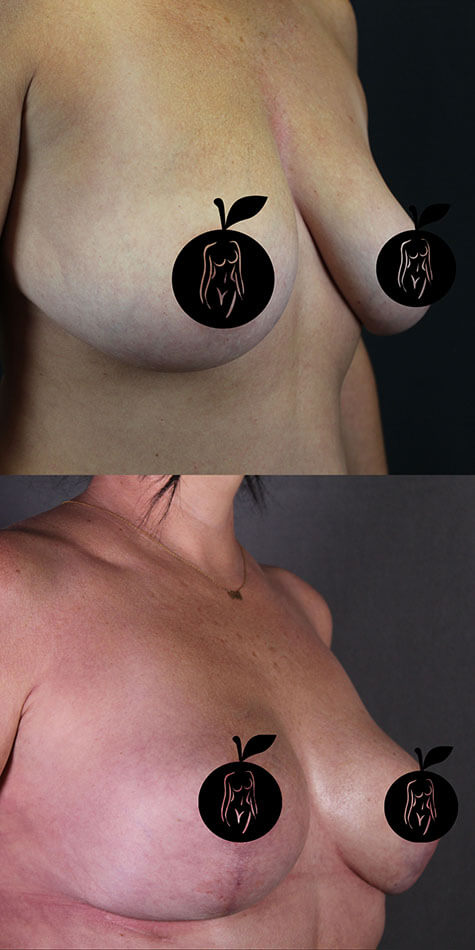
Breast Lift FAQs
Q. Who are the best candidates for a breast lift?
A. The best candidates for a breast lift are those who have drooping or sagging breasts. Ideal patients are also in good physical health, do not smoke, and have realistic expectations about the procedure.
Q. What complications can occur with a breast lift?
A. As with any surgery, there are risks and complications that can develop after a breast lift. Although rare, the more common complications include bleeding, infection, and numbness. Following your surgeon’s instructions will help reduce your risk for complications and ensure you have the safest recovery possible.
Q. How much does a breast lift cost?
A. The cost of a breast lift will depend on several factors, including how much ptosis (drooping) is present and the surgical technique to be used.
Q. Is a breast lift covered by health insurance?
A. Health insurance companies do not cover the costs of a breast lift, as this procedure is for cosmetic purposes only and not medically necessary.
